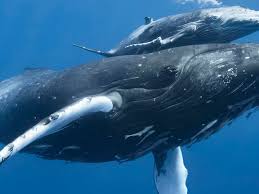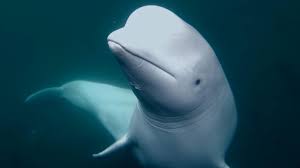Gently cruising through the frigid Arctic waters, the Narwhal (Monodon monoceros) is an enigmatic creature that captures the imagination with its distinctive long tusk, earning it the moniker of the ‘Arctic Unicorn.’ This small toothed whale, with its strange, spiral tusk piercing the air, has intrigued scientists and enthusiasts alike for centuries. ‘The Enigmatic Narwhal: Unveiling the Mysteries of the Arctic Unicorn’ is an exploration into the life and habits of this unusual marine creature, as we delve beneath the icy depths to bring to light the secrets of the Narwhal.
Physical Characteristics:
- The narwhal, often referred to as the Arctic Unicorn due to its singular, spiraled tusk, is characterized by its unique physical traits.
- Unlike many other marine mammals, the narwhal lacks a dorsal fin, instead possessing a dorsal ridge which aids in navigating the icy Arctic waters.
- The creature’s flippers, unlike most of their marine counterparts, are turned upwards that may contribute to their distinctive swimming style.
- Their bodies exhibit a mottled gray coloration, adding camouflage against the sea and ice.
- There is a significant size disparity between the sexes, with males generally being larger than females.
- Males typically weigh around 1,600 kg (nearly 1.7 tons), while females are smaller, weighing in at around 1,000 kg (approximately 1 ton).
Tusk Development
- The narwhal tusk, a unique feature, grows directly through the upper lip, creating a spectacular display. Unlike other toothed whales, narwhals do not grow teeth in their mouth. Instead, the left upper canine tooth spirals out, forming the long, renowned tusk.
- The tusk can grow up to 3 meters in length, often displaying a left-handed spiral groove along its length. This spiral pattern follows the direction of the growth from the base to the tip, a fact that has intrigued scientists for centuries.
- While primarily a male attribute, occasionally females will grow a tusk. Even rarer, some narwhals develop two tusks, a phenomenon that is not fully understood by scientists.
- Historically, the narwhal tusk has held significant cultural importance. In medieval times, narwhal tusks were traded and sold as unicorn horns, due to their long, spiraled appearance. The tusk’s association with the mythical creature has led to the narwhal being referred to as the “Arctic Unicorn.”
Related Post: The Majestic Bowhead Whale: A Comprehensive Overview
Function of the Tusk
The tusk of the narwhal has intrigued scientists for centuries due to its unique characteristics. Here are some theories and recent observations regarding its function:
- Hunting Tool: Recent observations suggest that narwhals may use their tusks for hunting. They have been observed stunning small fish with a quick flick of their tusk before ingesting them.
- Environmental Sensor: The tusk might function as a sensor, capable of detecting changes in the environment. Some studies indicate that the narwhal uses its tusk to measure salt levels in the water, which helps them navigate their Arctic habitat.
- Mating Competitions: Contrary to earlier beliefs held by naturalists like Charles Darwin, the tusk is not primarily used for aggressive mate competition. Instead, current theories suggest its use is more aligned with establishing hierarchical social structures.
Behavior and Social Structure
- Narwhals are social creatures, often found in groups of 15 to 20 individuals. This grouping behavior not only provides protection from predators but also facilitates cooperative hunting practices.
- In certain instances, these small groups can converge to form herds containing thousands of individuals. These large gatherings are typically seen during migration periods when narwhals move towards their summer feeding grounds.
- Reproduction in narwhals is an intriguing process. Newborn calves measure approximately 1.6 meters, indicating a significant growth rate considering the size of the adult narwhal.
- The weaning process in narwhals is a vital step towards independence. Calves begin to consume solid food along with mother’s milk around the age of one, and by the age of two, they are completely weaned.
- Narwhals reach sexual maturity between the ages of 6 and 8 for both males and females. Interestingly, female narwhals experience a form of menopause, a rarity in the animal kingdom. They stop reproducing at a certain age but continue to live for many years thereafter, contributing to the societal structure of the herd.
Diet and Predators
Diet:
- Fish: Narwhals have a varied diet, but fish constitute a significant portion. They primarily feed on Greenland halibut, along with Arctic and polar cod.
- Squid: Apart from fish, Squid are also a common component of the Narwhal diet. They dive deep into the ocean to hunt these creatures.
- Shrimp: Shrimp provide an essential source of protein and nutrients for Narwhals. They are consumed in considerable quantities, especially during the summer months.
Predators:
- Killer Whales: Known for their predatory skills, Killer whales pose a significant threat to Narwhals. They often hunt in packs and can easily outmaneuver the slower Narwhals.
- Polar Bears: While not aquatic predators, Polar bears often prey on Narwhals when they come up to the ice to breathe or become trapped in shifting ice patterns.
- Walruses: Although Walruses are not typically Narwhal predators, there have been instances of them attacking young or weakened individuals.
Human Impact:
- Inuit Hunting: The indigenous Inuit people have traditionally hunted Narwhals for their ivory tusks and nutrient-rich skin, known as ‘muktuk’. This hunting, however, is regulated and considered part of their subsistence lifestyle.
Environmental Challenges
- Increasing Pack Ice: With climate change triggering erratic weather patterns, incidents of narwhals being trapped by rapidly forming pack ice are escalating. As air-breathing creatures, they can find themselves in perilous situations when sea-ice freezes over their breathing holes.
- Impact on Local Inuit Hunters: Narwhals have been traditionally hunted by local Inuit people for centuries. However, the same unpredictable ice formation poses a significant threat to these hunters. Traps created by sudden ice can lead to dangerous situations, putting the lives of Inuit hunters at risk.
- Breathing Holes Closure: Narwhals rely on a network of breathing holes in the ice to survive. The unpredictable nature of ice formation in the Arctic can cause these holes to close off suddenly, posing a significant threat to the survival of these marine creatures.
Taxonomy and Origin
- Narwhals belong to the family Monodontidae, which is a part of the larger suborder Odontoceti. This suborder principally includes toothed whales and dolphins.
- Within the Monodontidae family, narwhals are close relatives of beluga whales. Although they inhabit similar Arctic regions, these two species possess distinct physical attributes and behaviors.
- The term “narwhal” originates from the Old Norse words ‘nár,’ meaning ‘corpse,’ and ‘hvalr,’ meaning ‘whale.’ This nomenclature references the creature’s ghostly, pallid exterior, reminiscent of a drowned sailor.
- In scientific taxonomy, narwhals are identified as Monodon monoceros, a name reflecting their unique single-tusked (monodon) and single-horned (monoceros) attributes. This remarkable tusk, a characteristic feature of male narwhals, is actually a long, spiraled canine tooth.
Conclusion
- Unique Features and Behaviors: The enigmatic narwhal, often referred to as the ‘Arctic Unicorn’, captivates the scientific community with its unique features and behaviors. Its iconic helical tusk, a protruding canine tooth that can reach up to 3 meters in length, and its ability to dive up to 1,500 meters deep are unparalleled in the animal kingdom.
- Ongoing Scientific Discoveries: New research continues to unravel the secrets of the narwhal’s biology and behavior. Recent studies suggest that the tusk, once thought to be a mere display feature, serves as a sensory organ, detecting changes in the environment and helping narwhals navigate the icy Arctic waters.
- Importance of Conservation Efforts: The narwhal’s survival is intricately tied to the health of its Arctic habitat. Threatened by climate change, pollution, and human interaction, urgent conservation efforts are imperative to safeguard this unique species – a testament to the splendor and diversity of life in the Arctic.




